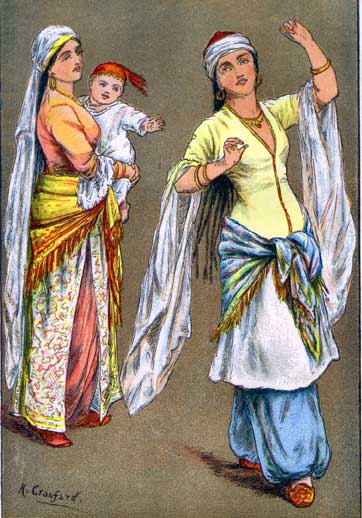Orient: Difference between revisions
No edit summary |
m (→Food and Drink) |
||
| (11 intermediate revisions by 2 users not shown) | |||
| Line 1: | Line 1: | ||
The lands to the east and south of Europe are shrouded in mystery to those Europeans who have never traveled beyond their own borders. Stories brought back by travelers, and those told by visitors from those realms, paint an image of lands very different than the ones they knew. But what were those stories based on? | The lands to the east and south of Europe are shrouded in mystery to those Europeans who have never traveled beyond their own borders. Stories brought back by travelers, and those told by visitors from those realms, paint an image of lands very different than the ones they knew. But what were those stories based on? | ||
This page is an attempt to compile information about the orient in 1811, focused primarily on Morocco, with perhaps a few side trips into the Levant and Ottoman Empire. Unless otherwise noted, all information is drawn from [http://books.google.com/books?id=fSAMAAAAMAAJ&pg=PR1#v=onepage&q&f=false Travels Through The Empire of Morocco,] by John Buffa, MD (1810). | This page is an attempt to compile information about the orient in 1811, focused primarily on Morocco (the homeland of [[Aaron Abdullah]]), with perhaps a few side trips into the Levant and Ottoman Empire. Unless otherwise noted, all information is drawn from [http://books.google.com/books?id=fSAMAAAAMAAJ&pg=PR1#v=onepage&q&f=false Travels Through The Empire of Morocco,] by John Buffa, MD (1810). | ||
| Line 7: | Line 7: | ||
==Middle Eastern Dancing== | |||
The standard modern western image of middle eastern belly dancing - the bedlah costume with veils and bikinis and such - was invented almost wholesale in the late 1800s by the | The standard modern western image of middle eastern belly dancing - the [http://en.wikipedia.org/wiki/Bedlah bedlah] costume with veils and bikinis and such - was invented almost wholesale in the late 1800s by the French, and the romantic painters making up ideas of what a harem must be like. | ||
This is closer to | This is closer to what ghaziya (gypsy dancers - the ones any westerner in the early 1800s might have seen) wore: | ||
[[File:ghawazi.jpg]] | [[File:ghawazi.jpg]] | ||
| Line 18: | Line 18: | ||
1880s, K. Craufurd. | 1880s, K. Craufurd. | ||
http://www.belly-dance.org/museum.php?Id=2 | http://www.belly-dance.org/museum.php?Id=2 | ||
more: | |||
http://www.belly-dance.org/ghawazee.html | |||
modern academic article: | |||
http://www.domresearchcenter.com/journal/24/Peretz-EgyptianGhawaziDance.html | |||
==Weapons and Military== | |||
Swords, cavalry, military, etc | |||
---- | |||
==Food and Drink== | |||
===sekanjabin=== | |||
A vinegar/honey/herb syrup, diluted with water to drink. | |||
http://www.3owls.org/sca/cook/oxymel.htm | |||
An Anonymous Andalusian Cookbook of the Thirteenth Century, tr. Charles Perry.: | |||
''Take a ratl of strong vinegar and mix it with two ratls of sugar, and cook all this until it takes the form of a syrup. Drink an ûqiya of this with three of hot water when fasting: it is beneficial for fevers of jaundice, and calms jaundice and cuts the thirst, since sikanjabîn syrup is beneficial in phlegmatic fevers: make it with six ûqiyas of sour vinegar for a ratl of honey and it is admirable. | |||
'' | |||
===Coffee=== | |||
Coffee and coffee brewing | |||
http://en.wikipedia.org/wiki/Turkish_coffee | |||
- mint tea | |||
- yoghurt ice water version | |||
- couscous, savory & sweet | |||
- halal vs haram | |||
[[Category:Articles]] | |||
Latest revision as of 17:07, 30 November 2016
The lands to the east and south of Europe are shrouded in mystery to those Europeans who have never traveled beyond their own borders. Stories brought back by travelers, and those told by visitors from those realms, paint an image of lands very different than the ones they knew. But what were those stories based on?
This page is an attempt to compile information about the orient in 1811, focused primarily on Morocco (the homeland of Aaron Abdullah), with perhaps a few side trips into the Levant and Ottoman Empire. Unless otherwise noted, all information is drawn from Travels Through The Empire of Morocco, by John Buffa, MD (1810).
Middle Eastern Dancing
The standard modern western image of middle eastern belly dancing - the bedlah costume with veils and bikinis and such - was invented almost wholesale in the late 1800s by the French, and the romantic painters making up ideas of what a harem must be like.
This is closer to what ghaziya (gypsy dancers - the ones any westerner in the early 1800s might have seen) wore:
1880s, K. Craufurd. http://www.belly-dance.org/museum.php?Id=2
more:
http://www.belly-dance.org/ghawazee.html
modern academic article:
http://www.domresearchcenter.com/journal/24/Peretz-EgyptianGhawaziDance.html
Weapons and Military
Swords, cavalry, military, etc
Food and Drink
sekanjabin
A vinegar/honey/herb syrup, diluted with water to drink.
http://www.3owls.org/sca/cook/oxymel.htm
An Anonymous Andalusian Cookbook of the Thirteenth Century, tr. Charles Perry.:
Take a ratl of strong vinegar and mix it with two ratls of sugar, and cook all this until it takes the form of a syrup. Drink an ûqiya of this with three of hot water when fasting: it is beneficial for fevers of jaundice, and calms jaundice and cuts the thirst, since sikanjabîn syrup is beneficial in phlegmatic fevers: make it with six ûqiyas of sour vinegar for a ratl of honey and it is admirable.
Coffee
Coffee and coffee brewing
http://en.wikipedia.org/wiki/Turkish_coffee
- mint tea
- yoghurt ice water version
- couscous, savory & sweet
- halal vs haram
